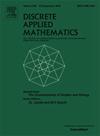On the vertices belonging to all edge metric bases
IF 1
3区 数学
Q3 MATHEMATICS, APPLIED
引用次数: 0
Abstract
An edge metric basis of a connected graph is a smallest possible set of vertices of satisfying the following: for any two edges of there is a vertex such that the distances from to and differ. The cardinality of an edge metric basis is the edge metric dimension of . In this article we consider the existence of vertices in a graph such that they must belong to each edge metric basis of , and we call them edge basis forced vertices. On the other hand, we name edge void vertices those vertices which do not belong to any edge metric basis. Among other results, we first deal with the computational complexity of deciding whether a given vertex is an edge basis forced vertex or an edge void vertex. We also establish some tight bounds on the number of edge basis forced vertices of a graph, as well as, on the number of edges in a graph having at least one edge basis forced vertex. Moreover, we show some realization results concerning which values for the integers , and allow to confirm the existence of a graph with vertices, edge basis forced vertices and edge metric dimension .
在属于所有边度量基的顶点上
连通图G的边度量基是满足下列条件的最小可能顶点S (G)的集合:对于任意两条边e,f (G)存在一个顶点S∈S,使得S到e和f的距离不同。在本文中,我们考虑图G中顶点的存在性,使得它们必须属于G的每一个边度量基,我们称它们为边基强制顶点。另一方面,我们将不属于任何边度量基的顶点命名为边空顶点。在其他结果中,我们首先处理了确定给定顶点是边基强制顶点还是边空顶点的计算复杂性。我们还建立了图的边基强制顶点数的紧边界,以及图中至少有一个边基强制顶点的边数的紧边界。此外,对于整数n, k和f,我们给出了一些实现结果,证明了图G具有n个顶点,f个边基强制顶点和边度量维k的存在性。
本文章由计算机程序翻译,如有差异,请以英文原文为准。
求助全文
约1分钟内获得全文
求助全文
来源期刊

Discrete Applied Mathematics
数学-应用数学
CiteScore
2.30
自引率
9.10%
发文量
422
审稿时长
4.5 months
期刊介绍:
The aim of Discrete Applied Mathematics is to bring together research papers in different areas of algorithmic and applicable discrete mathematics as well as applications of combinatorial mathematics to informatics and various areas of science and technology. Contributions presented to the journal can be research papers, short notes, surveys, and possibly research problems. The "Communications" section will be devoted to the fastest possible publication of recent research results that are checked and recommended for publication by a member of the Editorial Board. The journal will also publish a limited number of book announcements as well as proceedings of conferences. These proceedings will be fully refereed and adhere to the normal standards of the journal.
Potential authors are advised to view the journal and the open calls-for-papers of special issues before submitting their manuscripts. Only high-quality, original work that is within the scope of the journal or the targeted special issue will be considered.
 求助内容:
求助内容: 应助结果提醒方式:
应助结果提醒方式:


